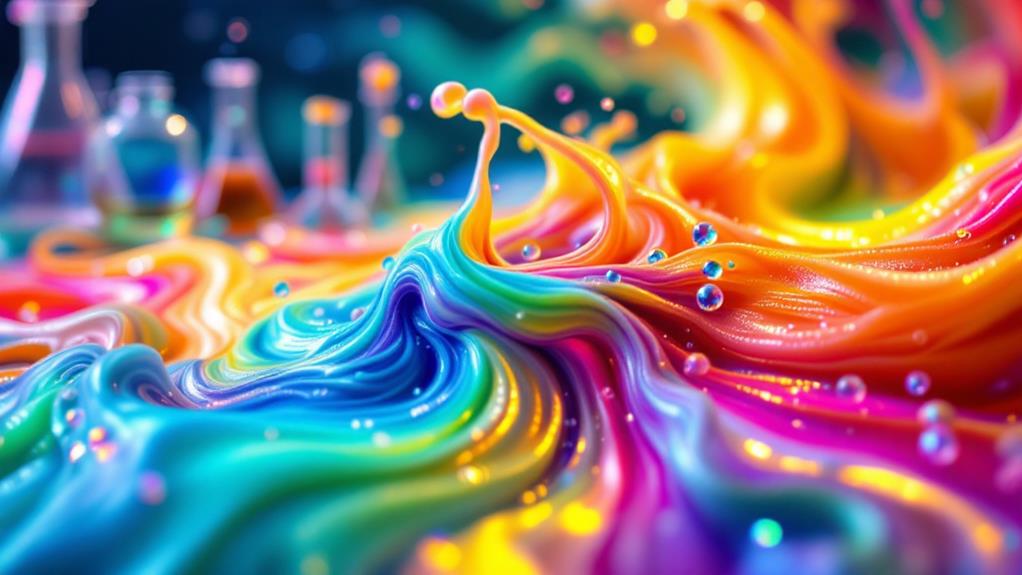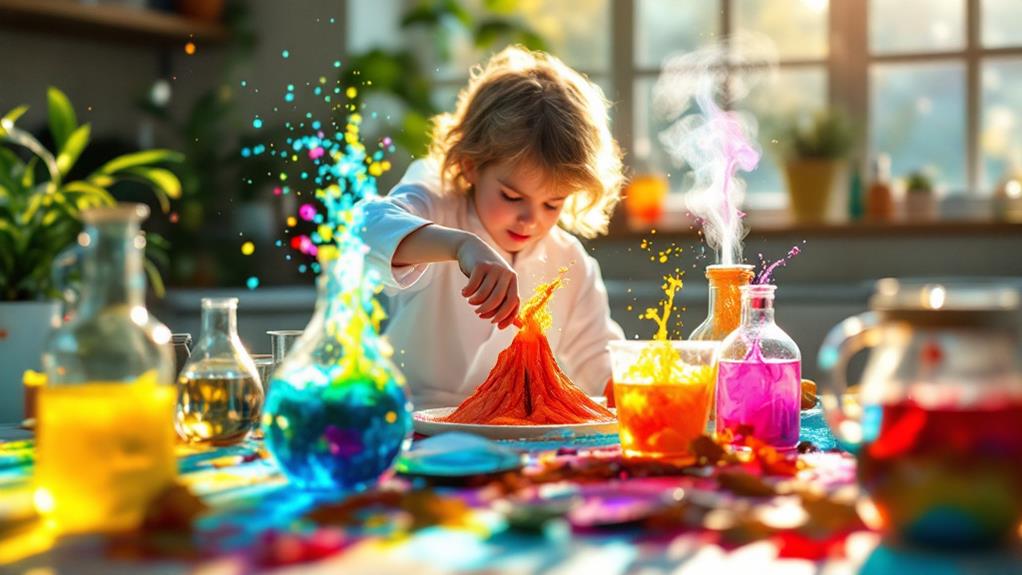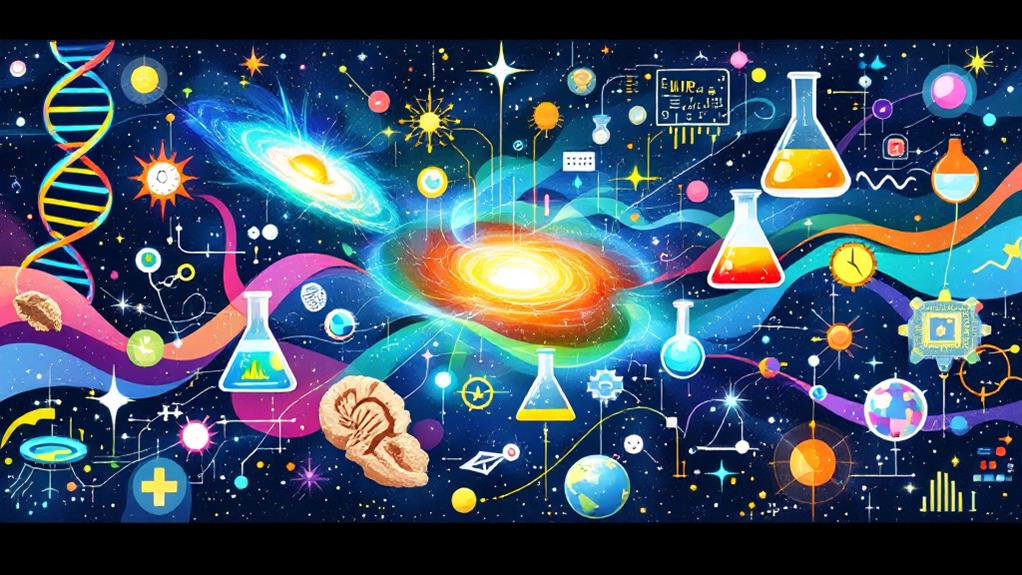Fun Facts About Colors: The Science and History Behind Our Perception
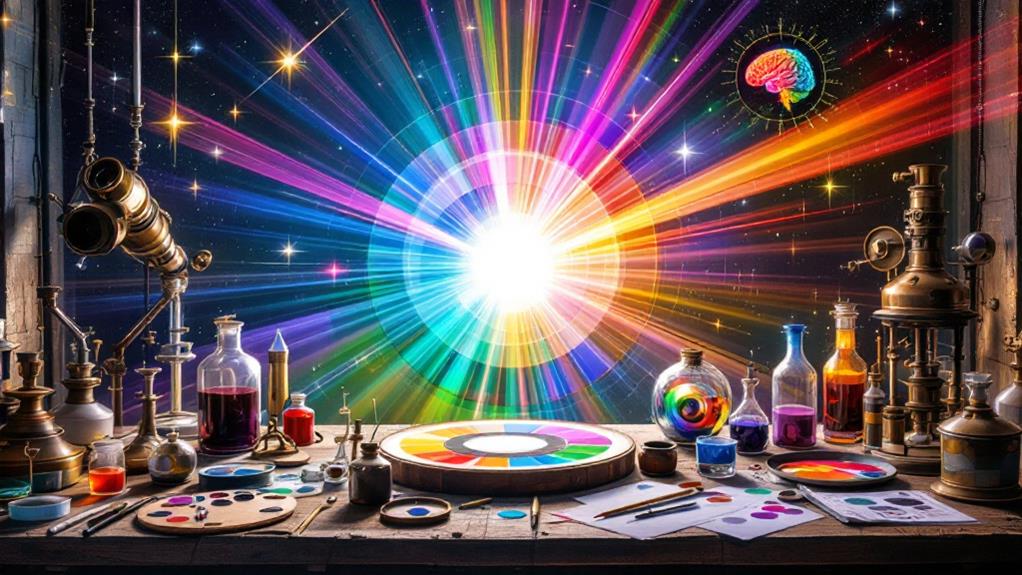
Colors are far more than meets the eye. They're electromagnetic waves your brain interprets, and animals perceive them differently. Bees see ultraviolet light, while mantis shrimp have 16 color receptors compared to your three. Colors carry cultural symbolism, with red signifying passion in the West but mourning in some Eastern cultures. Ancient civilizations valued specific hues, like Tyrian purple extracted from sea snails. Rainbows result from light refracting through water droplets, creating a unique spectacle for each viewer. Even color blindness has genetic roots. Exploring the world of color reveals a fascinating blend of science, history, and perception.
The Electromagnetic Spectrum
What exactly is color, and where does it come from? To understand this, you'll need to plunge into the fascinating world of the electromagnetic spectrum. This spectrum encompasses all types of electromagnetic radiation, including visible light, which is responsible for the colors we see.
The electromagnetic spectrum is a continuous range of wavelengths, from long radio waves to short gamma rays. Visible light occupies only a tiny portion of this spectrum, with wavelengths between 380 and 700 nanometers. Each color corresponds to a specific wavelength within this range.
When light hits an object, some wavelengths are absorbed while others are reflected. The reflected wavelengths determine the color we perceive. For example, a red apple absorbs most wavelengths except those in the red range, which it reflects back to our eyes.
The electromagnetic radiation properties of light, such as wavelength and frequency, play a pivotal role in how we experience color. Our eyes contain specialized cells called cones that respond to different wavelengths, allowing us to perceive a wide range of colors. This intricate interplay between light, objects, and our visual system creates the lively world of color we experience every day.
Color Perception in Animals
While humans perceive a rich array of colors, the animal kingdom offers an even more diverse gamut of color vision. Many animals have evolved unique color vision adaptations to suit their specific environments and survival needs. For instance, bees can see ultraviolet light, allowing them to detect patterns on flowers invisible to the human eye. This ability helps them locate nectar sources more efficiently.
Some creatures, like mantis shrimp, possess up to 16 color receptors compared to our three, enabling them to perceive an astounding range of colors. On the other hand, many mammals, including dogs and cats, are dichromats, seeing fewer colors than humans but excelling in detecting motion and contrast.
Nocturnal color perception is another fascinating aspect of animal vision. While humans struggle to see colors in low light, some nocturnal animals have adapted to perceive colors even in dim conditions. For example, geckos and toads have specialized rod cells that allow them to distinguish colors at night, giving them an advantage in plunge and hunting and avoiding predators. These diverse color perception abilities demonstrate nature's exceptional capacity for adaptation and specialization.
Cultural Symbolism of Colors
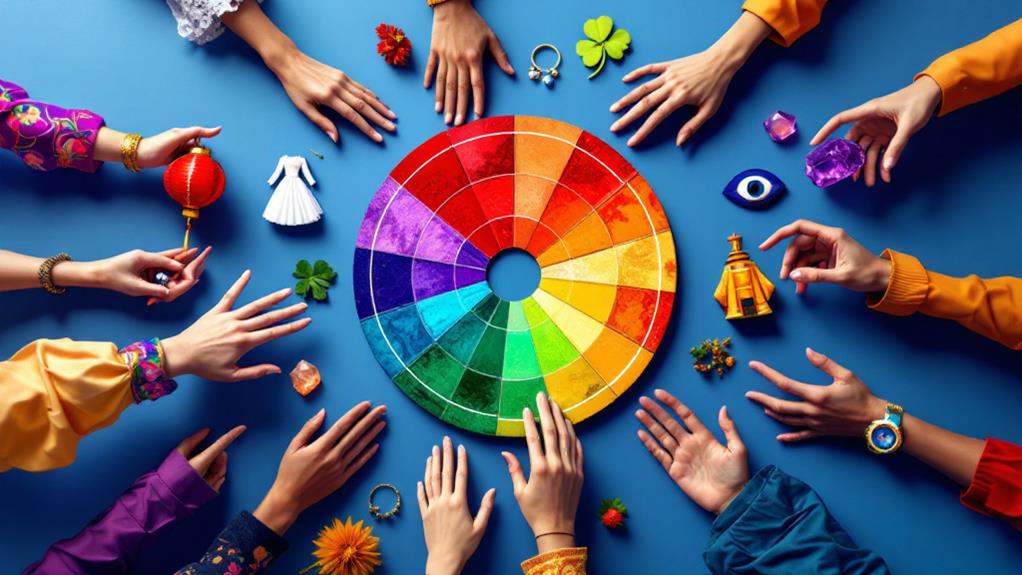
Colors carry deep meanings across cultures, symbolizing emotions, values, and concepts. You'll find that red often represents passion and danger in Western cultures, while it symbolizes good luck and prosperity in many Asian countries. White, traditionally associated with purity in the West, signifies mourning in some Eastern cultures.
These cultural interpretations of colors influence various aspects of society, including fashion trends and political symbolism. For instance, purple has long been linked to royalty and luxury, impacting high-end fashion choices. In politics, parties often adopt specific colors to represent their ideologies, like red for left-leaning parties in many European countries.
The symbolism of colors can evoke powerful imagery:
- A crimson flag waving proudly over a lively city square
- A serene white-clad bride walking down a flower-strewn aisle
- A sea of vibrant green banners at an environmental protest
- A somber black-clothed crowd gathered at a memorial service
Understanding these cultural associations can help you maneuver social situations, appreciate art and literature, and even make more informed decisions in marketing and design. The rich fabric of color symbolism continues to evolve, reflecting changing societal values and global influences.
Synesthesia and Color
Synesthesia, a fascinating neurological phenomenon, affects roughly 4% of the population and often involves color perception. If you're a synesthete, you might experience colors when you hear music, taste food, or read numbers and letters. This unique blending of senses creates involuntary color associations that remain consistent throughout a person's life.
For some synesthetes, days of the week or months of the year have distinct color identities. Others might perceive colors when they smell certain scents or feel different textures. These color associations can be vivid and automatic, often influencing emotional responses to various stimuli.
Interestingly, synesthesia isn't just limited to color perception. Some people experience taste when they hear certain words or feel shapes when they listen to music. Scientists believe that synesthesia results from increased connectivity between different areas of the brain.
While synesthesia isn't considered a disorder, it can sometimes be overwhelming. However, many synesthetes report that their unique perceptions enhance their creativity and memory. Artists, musicians, and writers often draw inspiration from their synesthetic experiences, using their color associations to create innovative works that challenge our understanding of sensory perception.
Historical Pigments and Dyes

Throughout history, humans have been enthralled by color and have gone to great lengths to create vivid pigments and dyes. From ancient cave paintings to modern-day fashion, the quest for vibrant hues has driven innovation and trade across civilizations.
Natural mineral pigments were among the earliest colorants used by our ancestors. You'd find these in:
- Ochre-painted handprints on cave walls
- Lapis lazuli-adorned Egyptian pharaohs' tombs
- Vermilion-tinted Chinese imperial seals
- Mayan blue-decorated temples in Mesoamerica
Rare vegetable dyes also played an essential role in color production. The Phoenicians famously extracted Tyrian purple from sea snails, while indigo from the Indigofera plant transformed the textile industry. These precious dyes were often worth their weight in gold, sparking global trade routes and even wars.
As you investigate the world of historical pigments and dyes, you'll uncover fascinating stories of ingenuity and cultural exchange. From the crimson cochineal beetles of the Americas to the saffron fields of Iran, each hue carries a rich legacy that continues to influence our colorful world today.
Color Psychology in Marketing
In today's competitive marketplace, savvy marketers utilize color psychology to influence consumer behavior and brand perception. You've likely noticed how certain colors evoke specific emotions and associations. This phenomenon forms the basis of color psychology in marketing, where brands strategically use colors to create desired impressions and responses.
The emotional impact of colors plays an essential role in branding. Red often signifies excitement and urgency, making it popular for clearance sales and fast-food chains. Blue conveys trust and reliability, which is why many banks and tech companies favor it. Green is associated with nature and health, making it a go-to for eco-friendly and wellness brands.
Color associations in branding can vary culturally, so marketers must consider their target audience. For instance, while white symbolizes purity in Western cultures, it's associated with mourning in some Eastern cultures. By understanding these nuances, brands can craft visual identities that strike a chord with their intended consumers.
You'll find that successful companies often use consistent color schemes across their marketing materials, reinforcing brand recognition and leveraging the psychological impact of their chosen hues.
Optical Illusions and Color
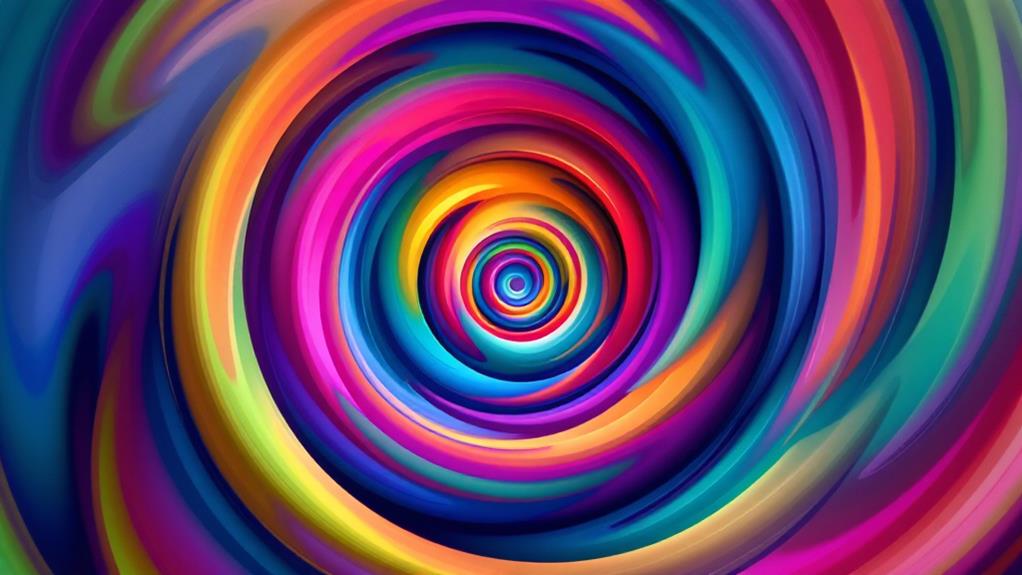
Color plays a fascinating role in optical illusions, often tricking our brains into perceiving things that aren't really there. When you stare at a brightly colored image for an extended period and then look at a white surface, you'll see an afterimage in the complementary color. This phenomenon, known as color afterimages, occurs because your eye's color receptors become fatigued and temporarily less sensitive to the original color.
Another intriguing effect is simultaneous color contrast, where surrounding colors influence how we perceive a central color. You'll notice this when the same shade appears different against various backgrounds. These illusions demonstrate how our visual system processes color information and adapts to environmental changes.
Here are some popular color-based optical illusions you might encounter:
- The Spinning Dancer: A silhouette that appears to rotate in different directions
- The Checkerboard Shadow: Identical squares seem to have different shades
- The Watercolor Illusion: Faint color appears to spread beyond its borders
- The Munker-White Illusion: Identical colors look different due to surrounding patterns
Understanding these illusions can help you appreciate the complexity of human color perception and how easily our brains can be fooled by visual stimuli.
Colors in Ancient Civilizations
Delving into ancient civilizations, you'll find that colors played a crucial role in their cultures, religions, and daily lives. From Egypt to China, color associations and symbolic meanings were deeply ingrained in society.
In ancient Egypt, you'd see blue representing the sky and divine power, while green symbolized growth and rebirth. Red was associated with life and victory, but also danger and chaos. The Egyptians created elaborate pigments, including the famous Egyptian blue, to adorn their temples and tombs.
Ancient Greeks had their own color symbolism. Purple signified royalty and wealth, while white represented purity and virtue. In China, you'd encounter red as a symbol of essential fortune and joy, used extensively in celebrations and imperial decor.
The Mayans valued blue highly, using it in their stunning murals and associating it with sacrifice. They created a unique Maya blue pigment that has endured for centuries.
These civilizations' understanding of color went beyond aesthetics. They used colors in medicine, believing certain hues could heal specific ailments. This rich history of color associations continues to influence modern interpretations and uses of color.
The Physics of Rainbows

From out of seemingly ordinary raindrops emerges one of nature's most spectacular displays: the rainbow. This colorful phenomenon is a result of the intricate physics of light interacting with water droplets in the atmosphere.
When sunlight enters a raindrop, it undergoes refraction of light, bending as it passes through the water. This process separates the white light into its component colors, much like a prism. As the light exits the raindrop, it's reflected back to your eyes, creating the vivid arc you see in the sky.
Specific atmospheric conditions are necessary for rainbows to form:
- Sunlight must be behind you
- Rain or mist must be in front of you
- The sun should be low in the sky (usually less than 42 degrees)
- The sky should be partly clear for the rainbow to be visible
You'll notice that rainbows always appear in the same order: red on top, followed by orange, yellow, green, blue, indigo, and violet. This sequence is determined by the different wavelengths of light, with red having the longest and violet the shortest. Curiously, no two people see exactly the same rainbow, as it depends on your unique viewing angle.
Color-Blindness and Genetics
Genetics plays a crucial role in how we perceive colors. Color blindness, a condition affecting millions worldwide, results from genetic mutations that alter the function of cone cells in our retinas. These mutations can occur on the X chromosome, which is why color blindness is more common in males than females.
You might be surprised to learn that color blindness isn't just about seeing in black and white. In fact, there are several types of color blindness, each affecting different color perceptions. The most common form is red-green color blindness, where individuals struggle to distinguish between these two hues. Less frequent are blue-yellow color blindness and complete color blindness.
Color blindness severity can vary greatly among individuals. Some may only have mild difficulty distinguishing certain shades, while others might experience significant challenges in daily life. Interestingly, many people with color blindness develop adaptive strategies to manage their environment effectively.
Scientists are exploring gene therapy as a potential treatment for color blindness. By targeting the specific genetic mutations responsible for the condition, researchers hope to restore normal color vision in affected individuals. While still in early stages, these advancements offer hope for future breakthroughs in treating color blindness.
